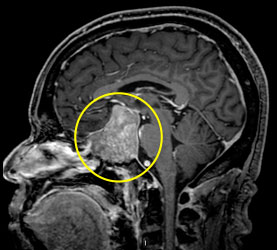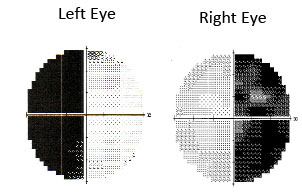Compressive optic neuropathy: Pituitary Tumor
The pituitary gland is located just behind and between our two eyes, inside our head. The pituitary gland regulates other glands and the hormones they secrete into our bloodstream. Up to 25% of the population can have a pituitary tumor, which is a benign (non-cancerous) growth of the normal pituitary cells. Most pituitary tumors remain small and do not cause any symptoms for several years or even in a lifetime.
Abnormal growth of the pituitary gland can lead to over or underproduction of the different hormones. However, hormone levels may also remain normal. If the pituitary tumor becomes large enough, it can press on the optic nerve or other nerves that control eye movements and sensation of the face. Patients may complain of decreased peripheral vision in both eyes, double vision, and/or numbness of the face.
If a pituitary tumor is suspected, visual field testing, pictures of the optic nerve, and a complete eye examination will be done. Brain imaging, such as an MRI, will be obtained for further evaluation. If a pituitary tumor is found, additional blood work to measure hormone levels will be obtained. Patients will also be referred to a neurosurgeon and endocrinologist for further evaluation. Certain pituitary tumors can be treated with medications, but most will need to be surgically removed.
An MRI with contrast from a patient with a large pituitary tumor, which is white in this image and within the yellow circle.
This is the visual field test result from a patient with a large pituitary tumor. The typical finding is vision loss in the right half of the vision in the right eye and left half of the vision in the left eye.
Visual recovery after treatment can be significant and almost immediate. However, the extent of recovery depends on the duration and severity of symptoms; in some cases, vision loss can be permanent despite treatment. Unfortunately, there are no treatments available for vision loss. Double vision, however, can be treated with fogging the vision in one eye, prisms, or eye muscle surgery.
For more information: view PDF brochure from the North American Neuro-Ophthalmology Society (NANOS).


